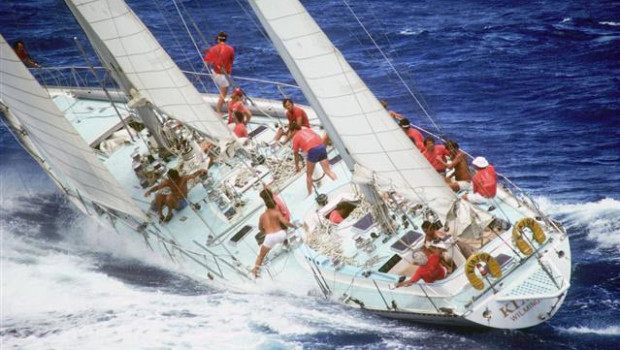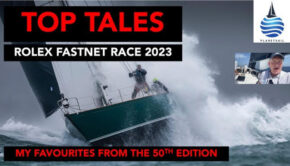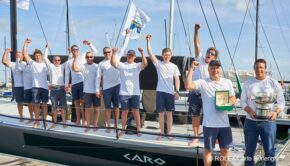Ocean Racing: It’s a character-builder
Published on December 10th, 2013
The esteemed Ned Shuman, Captain, USN (Ret), who successfully led the U. S. Naval Academy 56-foot aluminum sloop Alliance and a crew of midshipmen to finish the tragic 1979 Fastnet Race, often compared ocean racing in bad weather with being a prisoner of war.
“It is an environment with which, unfortunately, I have some experience,” said Shuman. “Harsh conditions, cramped quarters, bad food (really bad on boats stocked by midshipmen), and diverse personalities. Instead of the guards beating on you, mother nature takes over. You can’t get out so you make the best of it. It’s a character-builder.”
Author Roger Vaughan shares a passage from his book on the 1979 race ‘ Fastnet, One Man’s Voyage‘, in which Vaughan was among the crew aboard the S & S 79-foot Kialoa III…
We sat on deck encouraging the helmsman when he made a particularly adroit move to avoid a wave that looked certain to nail us. Driving was exhausting. The helmsman needed encouragement. He faced painfully into blowing scud that stung like sand looking for the optimum path through confused seas that lifted us up and up, and either rolled under us or struck full force.
The helmsman would yell a warning the moment he knew he had been beaten by one of the monsters, we would double our grip and tuck our heads in as thousands of gallons of solid water tried to smack us off the deck. We listened to gear straining, watched it work as the loads increased, felt the awesome forces tearing at the boat in a dozen directions at once from the sudden braking action of her bow slugging into a wave, or from the waves falling on us broadside at the same time heavy gusts struck. It didn’t seem possible that gear and vessel could bear such loads in combination with the terrible shocks they were receiving. One had to marvel at Kialoa’s performance, and also hope it was not short-lived.
The outhaul was the first to go. This was a piece of three-quarter-inch braided Dacron line rigged through a sheave at the end of the boom to the number three reef cringle on the shortened sail. Its job was to stretch the foot of the sail taut along the boom. It had been chafing in the sheave, out of sight of our constant inspection for chafe. It parted with the sound of a rifle shot.
The crew was so attuned to the possibility of gear failure that we all jumped at once, like sprinters coming off the blocks. Speed is of the essence when gear fails because the failure usually places an overload on other gear, with a potential domino effect. In this case the reef cringle was also tied around the boom to hold it down, but now the mains’l had inched forward along the boom in puckers, putting great strain on the small reef lines that went through lightly reinforced grommet holes in the sail itself. The whole middle of the sail could have been torn apart. Four men did a quick job reaving a new line and taking tension. They would get better at it. That outhaul would part twice more before the night was over.
In 2009, the 30th Anniversary of the 1979 Fastnet Race brought forth additional memories that were shared in Scuttlebutt. Click here to read them.









 We’ll keep your information safe.
We’ll keep your information safe.